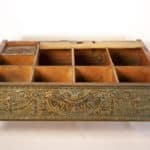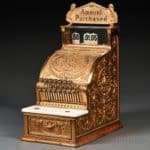Cash Registers
By Jeff Figler
It always amazes me that, when I go to check out at a store, when I give the cashier the payment, that the person will know exactly how much change I should receive. That has happened to all of us.
Sure, the cash register has a program that can automatically calculate how much change, if any, the customer should receive. Just like at gas stations when you pay by cash and you ask for money to be returned because you had given the cashier too much money when you prepaid.
Yes, it’s the 21st century, and things have changed since the Dark Ages, or the 20th century for that much. But when you’re as technologically challenged as I am, you marvel at all these developments, and wonder what is next.
But it all took time. Even the cash registers. How did it originate? Actually out of necessity. A Dayton, Ohio, restaurateur named James Ritty ran a popular café in the 1870s. However, as crowded as it always was, the café continually lost money. Ritty blamed it on the employees dishonesty, who often used an old cigar box for their transactions. There was no way to track sales. Ritty knew that something has to be done, so, while on a ship to Europe, he observed the workings of an automatic device on board that recorded the revolutions of the ship’s propellers. Ritty soon was trying to design a similar device that would record amounts of money passing through the cash drawer. By 1879, Ritty had assembled his first cash register. He quickly founded a cash register company.
Although Ritty did not sell many registers, he soon sold the company to a John Patterson, who would call the company the National Cash Register Company.
However, in the 1970s there were radical changes. Why? It was the dawn of the micro processing technology era. However, despite the upgrades, most companies realized that cash registers were still a necessity. You could not allow your employees to use outdated registers. Using old equipment would either indicate that you did not want to keep up with the times, or you had a liking and admiration for antiquities. Either way, eventually you had to change over.
But for collectors, there is a certain appeal to vintage cash registers. Collectors will keep an eye out for them, but they are popular auction items. Here are some examples of cash register sales.
A Class 400 National Cash Register (NCR), no. 1556612, c. 1916, built for Morris & Lipman in Plainfield, New Jersey, was made of brass and featured a crank handle, four rows of keys, receipt print-out on side, and the lower drawer had its original label attached to underside. The machine was not working and the crank arm and keys were jammed. Estimated at $200-$300, it sold just this past April for $492 at Skinner’s.
Also at Skinner’s, in 2013, a National cast bronze cash register from 1920 featured a plaque reading “Amount Purchased” with the serial number above a hinged glass case revealing that revealed the dollars and cents along with a customer count. Estimated to sell for $200 – $400, this register sold for $1,020.
A gilt bronze cash register manufactured by the NCR in 1913 sold for $1,750. Instructions are even on the back of the register as well as how to repair the machine and how to order supplies. This register is common to what you see when you picture an old bronze vintage cash register.
Online, you can purchase parts of cash registers along with complete ones. For example, an antique 1908 NCR Class 300 drawer is currently selling for $95.88, and an antique brass NCR crank handle is for sale for $59.95. Then there is an 1896 antique brass NCR Model 47 complete, and the owner is asking $995. And then there is shipping, which was described as being “packed and shipped professionally by UPS and shipped on a pallet.”
The cash register has changed dramatically, especially with the introduction of POS (Point of Sale) systems, your common registers that are computerized. The computerized registers use touchscreen terminals which allow for scanning of items, as well as for credit card transactions. These new registers also allow for the register operator to tell me how much change I’m owed, as well as to tell the operator how much change was owed a person who had made a $1.50 payment with a $100 bill. Just another example of relying on machines.
Jeff Figler has authored more than 600 published articles about collecting. He is one of the world’s leading experts on collectibles and is a former sports columnist for the St. Louis Post-Dispatch/STL Today, and San Diego Union Tribune. Jeff’s most recent book is Picker’s Pocket Guide to Baseball Memorabilia published by Krause Publications. You can learn more about Jeff by visiting his website www.collectingwithjeff.com. He can also be reached via email at info@jefffigler.com.









Related posts: